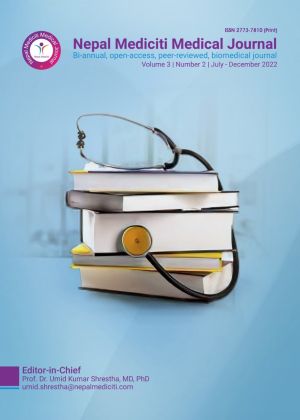An observational study on emerging antimicrobial resistance pattern in urinary tract Infection in Nepalese children
DOI:
https://doi.org/10.3126/nmmj.v3i2.52341Keywords:
Urinary tract infection, Uropathogens, antimicrobial resistance, culture positive, causative agentAbstract
AIMS Evidence-based management and local antibiotic susceptibility pattern provides evidence to guide the development of urinary tract infection (UTI) treatments protocols decreasing the economic burden significantly. We aimed to investigate the aetiology and resistance pattern of bacterial uropathogens to commonly prescribed oral antibiotics (beta lactamase and fluoroquinolones) causing UTI and to recommend the most appropriate antibiotics.
MATERIALS AND METHODS This study is cross sectional, retrospective study. We evaluated causative agents and antimicrobial resistance in urine, culture positive samples collected from July 2019 to June 2021 in a single hospital in Kathmandu, Nepal. To obtain urine samples, a midstream clean-catch method used in children who were toilet trained and transurethral catheterization performed in non-toilet-trained children. Urine samples were sent to the laboratory where they were inoculated using a 4 mm calibre loop on CLED (Cysteine Lactose Electrolyte Deficient) agar plate, and incubated at 37 °C for 18–24 h. Conventional methods (colony morphology, Gram stain) were opted. Different biochemical tests – catalase test, coagulase test and inoculation in Bile Esculin Agar was done for Gram-positive organisms, while Triple Sugar Indole (TSI) agar, Sulphide indole motility (SIM) agar, Simon's citrate agar and Christensen's urea agar were used for identification of Gram-negative bacilli. Significant growth was evaluated as ≥105 colony forming units (CFU)/ml of urine. Kirby-Bauer disc diffusion method was used to perform in vitro antimicrobial susceptibility tests in Mueller-Hinton agar plates. Total 13 drugs were tested for sensitivity pattern. To analyse resistance to antibiotics for different ages, subjects were divided into four age groups: Group I, 2 months - 1 year; Group II, 1 year - 5 year; Group III, 5 year - 10 year; Group IV, 10 year - 15 year.
RESULTS Among 970 samples sent, a total of 230 positive urine cultures were identified, of which 116 (50.4%) were from girls and 114 (49.6%) were from boys. The most common age group was 2 months to 1 year (49.1%). The most common causative agent was Escherichia coli (49.1%) followed by Enterococcus faecalis (14.3%) and Klebsiella pneumoniae (11.3%). The overall resistance to Nalidixic acid (66%), Ceftriaxone (54.8%) Cefotaxime (48.3%) Ciprofloxacin (47.9%) and Co-trimoxazole (46.9%) was significant. The least resistance was for Chloramphenicol, Nitrofurantoin, and Norfloxacin was 9.5 %, 31.5 %, and 38.3 % respectively. Chloramphenicol (90.5%) was the most active agent against E. coli and Klebsiella, whereas Linezolid (92.7%) and cloxacillin (64.9%) was most active against Enterococcus and Staphylococcus species.
CONCLUSION Escherichia coli was the most common causative agent of urinary tract infection in children. Nalidixic acid, Ceftriaxone, Cefotaxime, Ciprofloxacin and Co-trimoxazole had the highest resistance rates against urinary tract pathogens in our centre. For oral empirical antibiotic therapy, Chloramphenicol is the most appropriate choice for Escherichia coli and Klebsiella strains and Linezolid for Enterococcus species.
Downloads
Downloads
Published
How to Cite
Issue
Section
License

This work is licensed under a Creative Commons Attribution 4.0 International License.
This license enables reusers to distribute, remix, adapt, and build upon the material in any medium or format, so long as attribution is given to the creator. The license allows for commercial use.

